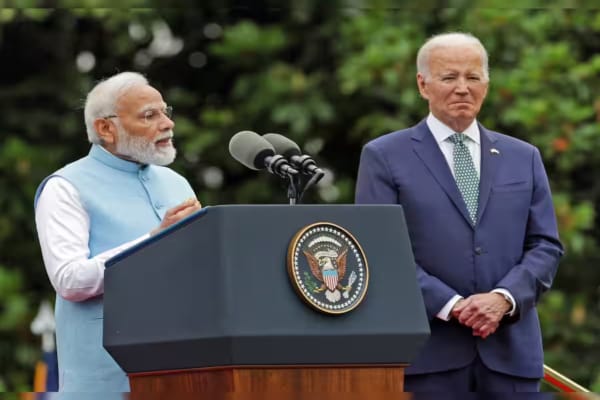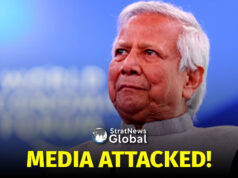Prime Minister Narendra Modi’s recent visit to the United States was as significant as US President Richard Nixon and his National Security Adviser Henry Kissinger’s historical visit to Beijing in February 1972, “which opened the world to China”, believes Nitin Gokhale, editor-in-chief of BharatShakti.in and its sister sites Stratnewsglobal.com and Interstellar.news.
In a wide ranging interview to Neelanjana Banerjee for BharatShakti, Gokhale, who was in Washington DC during Prime Minister Modi’s visit at the invitation of the US-India Business Council, said just like Nixon’s visit 52 years ago was a seminal moment for China, Modi’s state visit to the US earlier this month was a seminal moment for India “because it allows Indian businesses, Indian Diaspora, Indian academics and institutions as well as Indian citizens to access all that is beneficial for India from the American system.”
According to Gokhale, the USIBC event “was called IndUS X, where X stands for the X factor.” And the X factor essentially is innovators, startups, small businesses from both sides can come together “on a bridge provided by associations like the USIBC, and the Confederation of Indian Industry or CII and the Society of Indian Defence Manufacturers on the Indian side, and actually be a part of larger projects in their respective defence systems, or each other’s defence systems, then it gives an unprecedented boost to these businesses. There are of course older relationships in terms of trade and commerce, but this USBIC roundtable sets the roadmap for the small and medium industries in the defence sector, and also startups and innovators who are coming up with cutting edge technology for the use of the armed forces on either side.”
Gokhale, who met several Indian Americans and senior US administration officials and attended some of Modi’s various events across Washington, said his overall sense was that “this is the moment to seize for India, because the US is more open for business than ever before to do business and bring India on board to become a force to reckon with in terms of future defence tech, and also as a trusted partner in the international arena in terms of the geopolitical contest between the US and China. The US very much wants India on its side. India will of course try and retain its autonomy while doing business with the US for its own interests.”
This marks a very significant shift in India’s approach to the US, he felt, although “the suspicions remain about each other’s deep states and all that. But as Prime Minister Modi said a few years ago, India has truly shed some of the hesitations of the past, and is willing to join the US for the larger benefit of the country and the people.”
Gokhale also met Vivek Lal, the Chief Executive at General Atomics Global Corporation, the American energy and defence corporation headquartered in San Diego, California, famous for its cutting-edge specialisations in defence research and technology development. In the joint statement at the end of Modi’s visit, it was formally announced that India plans to procure 31 armed General Atomics MQ-9B High Altitude Long Endurance (HALE) Unmanned Aerial vehicles (UAV), which include 15 SeaGuardians for the Indian Navy and 16 SkyGuardians — eight each for the Indian Army and Air Force.
Colloquially know as Predators, “these drones actually killed many insurgents– and innocents—under the Obama administration in Afghanistan and Pakistan and other places. The same drone also took out General Sulemani, the controversial Iranian General, so it is a very effective weapon,” said Gokhale. “India has been eyeing this weapon for a long time, primarily for Intelligence, Surveillance, and Reconnaissance (ISR) Operations more than for kinetic kills, for its armed forces, and finally the Ministry of Defence agreed to procure some 31 of them from General Atomics. Now that technology is fully controlled by the US government.” The fact that the US agreed to give this technology to India, and MQ9-B, the latest version, making it only the second country after the US to have this, is a sign of how much trust the US has in India, he said. “ Of course there is a long way to go, the contract has to be negotiated, the price has to be finalised, etc,.”
However, not much technology will be transferred because it is IP protected and the US will not give this high-end technology, he added. But “General Atomics has agreed to assemble the platform in India with a local partner, and open a Maintenance, Repair, Overhaul (MRO) Centre in India for the HALE, and make some sub-components, like the landing gear, maybe even the integral missile that will come with the armed version, after the partner is chosen,” he said. And all this will obviously take some time, but it is again taking the India-US defence relations to a higher level.
The other exciting deal was to get the F414 jet engine from General Electric, which will be manufactured in India in collaboration with HAL. The Tejas LCA Mark II will have this engine, with a thrust of more than 125 KiloNewtons, compared to the Kaveri engine produced in India has only managed 75 KN. But only 80 per cent of the technology will be transferred to HAL, the full technology transfer is not happening because no country parts with the very high end technology needed to make jet engines, he added.
He then went on to discuss the need for bureaucrats in both nations to get their act together to produce early results and maintain the momentum, to avoid earlier mistakes, licences and security clearances must come quickly. Given that this whole thing was being driven top down by President Biden and Prime Minister Modi, he felt this was unlikely to be a roadblock.
“I am hopeful that both countries will move quickly before the end of the year, because next year both nations will go into election mode. So the window of opportunity is limited, and we must seize it,” he concluded.
To watch the full interview, click here
Modi’s US visit:
https://bharatshakti.in/breakthrough-moment-for-indo-us-ties-general-atomics-ceo-on-mq9b-drone-deal/
https://bharatshakti.in/cost-of-us-drones-not-fixed-yet-speculative-reports-bid-to-derail-acquisition-says-defence-ministry/





